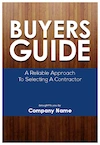Tom Rosendahl, the senior VP of Sales and Marketing for Dakota Supply Group, located in Grand Forks, N.D. recently wrote an article in the DSG magazine “Connections”. He said:
“Some contractors hear the word ‘upsell’, and it conjures up images of hucksters and con artists. To them, the word upsell means, ‘sell my customers something’. While this is hardly a sinister ulterior motive (we are all in the business of selling something, after all), most contractors don’t see themselves as salespeople. They simply see themselves as ‘installers.'”
“Here’s something that will blow your mind: successful contractors are salespeople. But there’s a trick. The most successful contractors don’t focus on selling; instead, they focus on helping customers get what they want. That’s the most important part, you see. If you don’t ask customers what they want and offer them options to choose from, you’ll never really know if you’ve satisfied their needs.”
Help your clients with our Buyers Guide
Guide your potential remodeling or renovation clients to find the contractor of choice for their job.
Order it Here
Thank you Tom!
If you are in business, you are in sales. No rationalizing, you are in sales. If you don’t sell something at a profit, you are going to go away. That’s not a new revelation, you have heard me say it before. However, Tom’s second point is what takes this process from difficult to easy. If you think in terms of helping others get the things they want and need, instead of trying to “sell” them something, you will have a decidedly different approach to the sales process and a much higher chance of success.
When you are in front of someone who wants to buy, the smart salesperson / contractor gets out of the way and lets them. But while they are at it, if they want a light switch, would a dimmer be as good or better? If they want a new dishwasher, isn’t a quiet dishwasher a better buy? Who hasn’t stayed awake listening to their tired old dishwasher grind clean another set of supper dishes?
Your customers are no different than you. But if you don’t ask the questions, they will never know what is available. Ask.
Upselling is about providing a better opportunity for your customer. Zig Ziglar says you can get everything in life you want if you will just help enough other people get what they want.
Good salespeople don’t pressure; they present choices and share their experiences. They let their customers make up their own minds and determine the cost versus value of your proposal. Good sales people understand that high pressure selling is trying to get customers to buy something they neither want nor need. There is a difference between high pressure selling and simply asking questions to find out what the customer really wants.
But upselling is also about making more money. Setting sales goals for your products or services and then exceeding them helps you reach your breakeven point earlier in the year and thus increase your profits. Let’s take a quick look at how to do this.
Let’s assume you have a company that will do about $275,000 in sales this year. Your overhead is projected to be $69,435. You want to make an 8 percent net profit. 8 percent of $275,000 is $22,000. So your gross profit is $91,435 (overhead of $69,435 plus net profit of $22,000). Now to get our gross margin, (which we need to calculate our breakeven point) we simply divide $91,435 by our projected sales for the year of $275,000 and we get the Gross Margin of 33.25 percent.
To calculate our breakeven point for this year, we divide our total overhead by our gross margin and we get $208,827. ($69,435 / .3325 = $208,827). That means that when our sales reach $208,827, we have sold enough to pay our overhead costs for the year. The remaining sales for the year will generate our profit.
To calculate the date we will breakeven, divide the breakeven sales of $208,827 by the total projected sales:
$208,827 / $275,000 = 75.94 or 76 percent of the year.
76 percent of 365 = 277 days or about October 4.
What happens if we increase our weekly sales average by $250 a week by upselling?
Increasing our sales by $250 a week for 50 weeks in a year gives us additional annual sales of $12,500. That would increase our projected sales from $275,000 to $287,500.
Now we need to recalculate our breakeven date.
$208,827 / $287,500 = 72.64 or 73 percent of the year.
73 percent of 365 = 266 days or about September 23. We will reach our breakeven point about 11 days earlier than our original projections.
So what does that mean for our business? By offering our customers the opportunity to purchase something a little better, if they choose to accept that opportunity we will reach our breakeven point earlier in the year and increase our profits at the same time. An additional $12,500 in sales, with a gross margin of .3325 means $4,156 extra gross profit.
Keep your focus on returning all phone calls, making appointments on time and providing good service. While you’re at it, watch for every opportunity to give your customers more than one choice in a purchase decision. You’ll never know if they want it unless you ask.
The knowledge and experience Michael Stone gained in his 60+ years in construction has helped thousands of contractors improve their businesses and their lives. He is the author of the books Markup & Profit Revisited, Profitable Sales, and Estimating Construction Profitably, and is available for one-on-one consultations.


 wpDiscuz
wpDiscuz